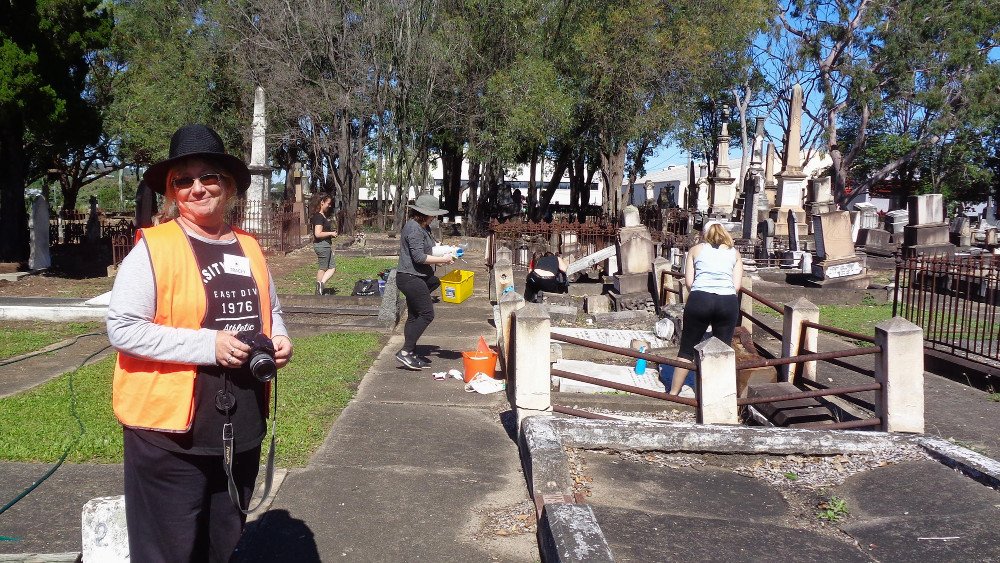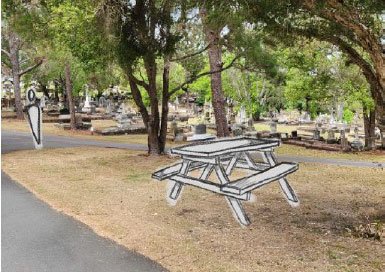Bringing life back to the cemetery
Toowong Cemetery monument sketch (Caitlyn Mulcahy, 2023)
So, you’ve clicked on our blog post about bringing life back to cemeteries, wondering what it could possibly be about. No, we’re not proposing ancient rituals, dark enchantments, or zombie apocalypses (sorry to disappoint fans of the dark arts or The Walking Dead). Nope, we’re talking about placemaking!
In this blog post based on Fourfold Placemaking Consultant Caitlyn Mulcahy thesis, we discuss placemaking principles that could help activate underutilised greenspace in cemeteries, increase the quality of experience of those visiting cemeteries and bring some much-needed attention to these undervalued social and cultural places. This blog builds on Caitlyn’s research undertaken as part of her Bachelor of Urban Development thesis project.
A new context for urban greenspace
Access to public greenspace is incredibly important in helping provide opportunities for our daily ‘green’ connection, but also in encouraging social interaction with others in our communities. In a changing and increasingly urbanised world, there is a growing need to creatively consider how we can provide better inner-city greenspaces. This is especially pressing as density increases and people experience decreased access to both public and private natural areas.
Cemeteries as public greenspace
The use of cemeteries for park-like purposes has been explored to a relatively minimal extent both globally and within Australia, however, it could be a highly viable option for community use.
Global research has shown that people are generally willing to interact with cemeteries for activities like walking, jogging and cycling. Though this is a positive sign, indicating a willingness to use these spaces outside of their conventional purpose, consideration needs to be given toward encouraging people to stop and spend time. We also need to ensure that activities still allow plenty of space for peaceful reflection and respectful memorial.
In terms of the research, it seems that many people are still divided on whether using cemeteries for purposes other than mourning or memorial is socially acceptable. However, local communities may be open to increasing visitation to and activation of cemeteries in a variety of ways, provided the right amenities are available and the context can be respected.
A fresh perspective
By looking at cemeteries through a placemaking lens, we can start to see that they can be made more appealing as public greenspaces. These peaceful, history rich environments shouldn’t frighten us, but rather help us to find ways to co-exist with our shared human experiences.
Raising the profile of cemeteries and increasing their usability could help people to celebrate the lives of their loved ones. This could be achieved by ensuring that on-site amenities (such as seating, shade, rubbish disposal and public toilets) are well provided and that the design and layout of the landscape is appealing and easy to navigate. We should seek to help someone visit a gravesite with ease, and encourage them to spend as much time as they need in a comfortable and beautiful space. All of which can be achieved with good design and placemaking practices.
Naval Cemetery Landscape in Brooklyn New York designed by Nelson Byrd Wolz (image from ASLA).
Increased usability through interventions such as safe pathways, beautiful landscaping, design, signage, public art and points of interest, ensure that features can be enjoyed by all equally.
Placemaking solutions for cemeteries
The possibilities for cemeteries as beautiful and useable greenspace for inner-city areas is evident.
We have four thoughts on how cemetery design can be approached from the perspective of placemaking and urban design in order to unlock potential.
Inviting the community in
With increased visitation, people can become champions of their local cemetery, as in the case of the ‘Guardian Angels’ of the Friends of the South Brisbane Cemetery. Purposeful community engagement, activation and placemaking activities could help to build local ownership and connection to cemeteries.
Guardian Angel volunteers maintaining graves at the South Brisbane Cemetery (Friends of South Brisbane Cemetery).
2. Activation and commercial offerings
Increased activation through commercial offerings might sound a bit unusual within the context of a cemetery, however encouraging use of open spaces that don’t contain graves is a great way to help people to interact and raise the profile of cemeteries. Ideas for activities and activation include providing picnic spaces, cafes or food kiosks and opportunities for guided or self-guided tours. Toowong cemetery has even hosted outdoor performances from Vulcana Women’s Circus, under strict rules and guidelines for conduct. Although admittedly, this could be either high art, highly controversial, or both… depending on your perspective (Lazaroo, 2020).
In the case of activations and commercial offerings, it could provide opportunities for people to relax and remember loved ones while engaging in social activities such as sharing a meal with friends and family. It can also help people to learn more about the history and heritage of an area by visiting graves of historical figures or viewing performances that expose local history. So long as the context is respected, behaviour is respectful, and activities don’t take place within areas that include graves or headstones, these offerings could exist harmoniously and increase the use of a cemetery.
3. Improved wayfinding and walkability
Directional signage and creative wayfinding could help increase the walkability of a cemetery and ability to help people to better interact with graves. Dedicated and well-designed footpaths and stairs can provide better access, especially in considering accessibility for people with disabilities (like providing handrails, designing paths with the correct grading and materials, and widening paths). Finally, increasing separation between cars and pedestrians allows visitors to walk safely and keep away from traffic.
Concept sketch of parallel parking (left) and footpath and handrail at Toowong Cemetery (Caitlyn Mulcahy, 2023).
A communal grave site at the Rosenberg Cemetery in Winterthur, Switzerland, features wide paths and seating (Krebs und Herde Landschaftsarchitekten).
4. Increasing a sense of comfort and access with amenities.
There are a number of practical amenities that could help improve peoples’ experience of using the cemetery, including seating, parking, traffic signage, lighting, bins and water fountains. By providing easy access to these amenities, people have the ability to use cemeteries comfortably and spend more time enjoying the space. It also means that other uses, such as exercise and activations, can be better supported.
In a case study from Toowong Cemetery, Caitlyn’s observations and data gathering found that whilst the cemetery is well maintained by local Council, it lacked some facilities to increase its comfort and use, such as adequate and accessible parking and seating.
Concept sketch of picnic table seating for Toowong cemetery (Caitlyn Mulcahy, 2023)
Concept sketch of coffee kiosk in Toowong Cemetery (Caitlyn Mulcahy, 2023)
The Fawkner Park Memorial tearooms in Victoria host post-funeral or memorial functions and allow people to purchase fresh flowers and share a drink and a meal after they have visited a loved one’s grave or memorial site (image from Fawkner Park memorial tearooms).
Cemeteries offer so much potential for use as shared urban greenspaces. It would be a shame to not be able to widen our point of view and see new possibilities for how we enjoy local outdoor areas and celebrate the lives of people who have passed. With so many ways to increase amenity and use of cemeteries, perhaps it’s time to lay our fears and prejudices about sharing space with the dead to rest, once and for all.
This content formed part of Caitlyn’s thesis project on designing Australian cemeteries using placemaking principles to increase their activation as public greenspaces.
If you would like to discuss ways that you could re-vitalise your local cemetery and provide better community access to urban greenspace, we would love to hear from you!
Useful sources:
Grabalov, P. (2018) Public life among the dead: Jogging in Malmö cemeteries, Urban Forestry & Urban Greening, Volume 33, Pages 75-79, ISSN 1618-8667, https://doi.org/10.1016/j.ufug.2018.01.027.
Lazaroo, N. (2013). Circus in the cemetery: Transforming space and unearthing memory in vulcana women’s circus performance, grave effects of notable women. Australasian Drama Studies, (62), 194–205. https://search.informit.org/doi/10.3316/informit.157644753450237








